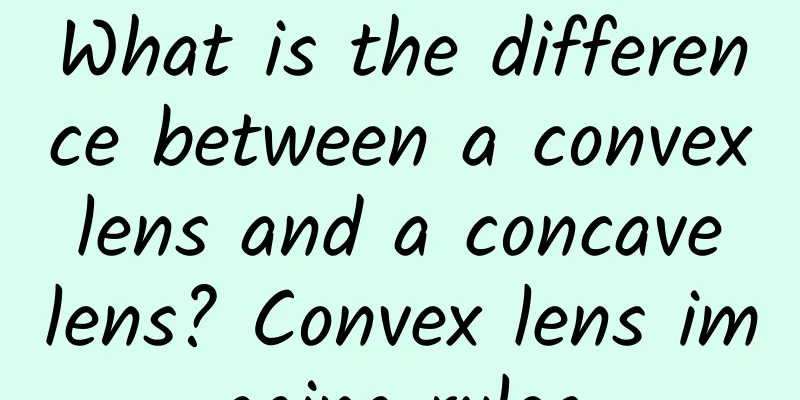What is the difference between a convex lens and a concave lens? Convex lens imaging rules

|
We all know that convex lenses and concave lenses are two different things, they have their own characteristics, for example, convex lenses use refraction to form images, which has a convergence effect on light, while concave lenses use reflection to form images, which has a reflection effect on light. So what happens when you put the two together? Let's enter the world of exploration together! Contents of this article 1. Distinguishing between convex lens and concave lens 2. What is the imaging law of convex lens? 3. What happens when a convex lens and a concave lens are placed together? 1Distinguishing between convex lens and concave lensIn fact, convex lenses and concave lenses can be distinguished by their different compositions, applications, and effects. Convex lenses are a refraction phenomenon. The lens is thick in the middle and thin on both sides. The image formed is inverted and reduced, and it has a focusing effect on light. Hyperopia glasses are convex lenses, while concave lenses are thin in the middle and thick on both sides. Myopia glasses are concave lenses. Convex lens Generally speaking, the main difference between convex lens and concave lens is their composition, and their principles are opposite. Convex lens is called positive spherical lens, which is very thick in the middle and very thin on both sides, and is mainly convex in shape, and has the effect of converging light, while concave lens is very thin in the middle and very thick on both sides, and is concave in shape. concave lens A convex lens is an image formed by the actual light produced by the reflection or refraction of an object. The image formed in the convex lens is inverted and reduced. Hyperopia glasses are convex lenses, while concave lenses are images formed by the reverse extension of light. They are mainly used in solar cookers, table lamps, etc. Myopia glasses are also concave lenses. Convex lens A convex lens is a refractive image. The image it forms can actually be viewed directly with the naked eye or received on a light screen. It can generally be tested with a light bulb. A convex lens can produce parallel light rays, while a concave lens cannot. A concave lens is a reflective image, and the image it forms is a virtual image. 2What is the imaging law of convex lens?The imaging law of a convex lens is that when an object is placed outside the focus, an inverted real image is formed on the other side of the convex lens. Real images can be divided into three types: reduced, equal-sized, and enlarged. It has a converging effect on light and is an optical law. The image that can be presented on the light screen is called a real image. The imaging law of a convex lens is that when an object is placed outside the focus, an inverted real image is formed on the other side of the convex lens. Real images can be divided into three types: reduced, equal-sized, and enlarged. It is an optical law. The image formed by the convergence of actual light and that can be presented on a light screen is called a real image. When distinguishing between real and virtual images, you can check whether the image is upright or inverted. Real images are inverted, while virtual images are upright. Lenses can be divided into convex lenses and concave lenses. Convex lenses are thinner at the edges and thicker in the middle. At least one surface must be made into a spherical surface. A concave lens is thick at the edges and thin in the middle. At least one of its surfaces is made of a spherical surface. It mainly has a diverging effect on light and can only form a positive, reduced virtual image. The convex lens mainly has a converging effect on light. 3What happens when you put a convex lens and a concave lens together?Convex lenses and concave lenses can be put together to make a telescope, thereby increasing the visual angle of an object to the human eye. The real image formed by the refraction of light through the telescope objective lens will be at a focus behind the eyepiece, which is a virtual image for the eyepiece. After refraction, it will become an upright virtual image. We all know that convex lenses and concave lenses are two different things. They have their own characteristics. For example, convex lenses use refraction to form images and have a converging effect on light, while concave lenses use reflection to form images and have a emitting effect on light. If convex lenses or concave lenses with different focal lengths are put together, a telescope can be made to increase the visual angle of objects for the human eye. The famous Galileo telescope is composed of these two, and its objective lens is made up of a combination of convex lenses and concave lenses. The combination principle of this telescope is extremely reasonable. The real image formed by the refraction of light through the objective lens will be at a focus behind the eyepiece, which is a virtual image for the eyepiece. After refraction, it will become an upright virtual image. |
>>: A man's happiness lies on this "fishing rod"!
Recommend
What is the appropriate water temperature for pregnant women to take a bath
What is the appropriate water temperature for pre...
During the Spring Festival, people eat a lot of meat and fish, but the toilet "punch time" is too long. How to improve it?
During the Spring Festival, most people are on ho...
Do I need to hold my urine to detect follicles?
Under normal circumstances, people should not hol...
Symptoms of high prolactin in women
Important reminder: In daily life, many women enc...
The causes and suggestions of abdominal pain in eight months of pregnancy
What should you do if you have lower abdominal pa...
Do you understand these methods to distinguish between benign and malignant ovarian cysts?
Most ovarian cysts are benign. When the disease w...
What should women pay attention to in terms of maintenance?
When we are young, we may not pay so much attenti...
How many months of pregnancy can you not sleep on your back?
Everyone's sleeping position is different, an...
This kind of delicacy is recommended all over the Internet as soon as summer comes, but I advise you not to eat it!
Summer is here, and it is the perfect season to e...
What are the things that women cannot use on their private parts?
Women need to be healthy, especially their privat...
How many degrees is a low fever in pregnant women
Low fever refers to a temperature lower than the ...
How to treat the symptoms of endocrine disorders in women
Many women are troubled by endocrine imbalance. A...
The breasts feel hard
As a girl, it is very important to pay attention ...
What are some exercises for women's chest?
Many women hope to have fuller breasts, which wil...
Itchy nipples 6 months pregnant
Pregnant women should take care of their bodies d...









